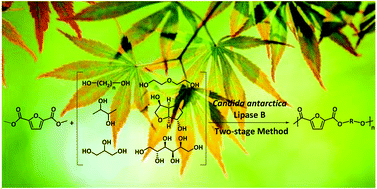A biocatalytic approach towards sustainable furanic–aliphatic polyesters†
Abstract
An eco-friendly approach towards furanic–aliphatic polyesters as sustainable alternatives to aromatic–aliphatic polyesters is presented. In this approach, biobased dimethyl 2,5-furandicarboxylate (DMFDCA) is polymerized with various (potentially) renewable aliphatic diols via Candida antarctica Lipase B (CALB)-catalyzed polymerization using a two-stage method in diphenyl ether. A series of furanic–aliphatic polyesters and oligoesters is successfully produced via enzymatic polymerization. Some products reach very high  (weight average molecular weight) values of around 100 000 g mol−1. Studies on the effect of the diol structure on the enzymatic polymerization indicate that CALB prefers long-chain alkane-α,ω-aliphatic linear diols containing more than 3 carbons. We also found that the molecular weights of the obtained furanic–aliphatic polyesters increase steadily with the increase of reaction temperature from 80 to 140 °C. MALDI-ToF MS analysis reveals that five polyester species may be present in the final products. They were terminated with the ester/–OH, ester/ester, –OH/–OH, no end groups (cyclic), and ester/aldehyde groups, respectively. Furthermore, the structure–property relationships were studied by comparing the crystalline/thermal properties of a series of relevant furanic–aliphatic polyesters.
(weight average molecular weight) values of around 100 000 g mol−1. Studies on the effect of the diol structure on the enzymatic polymerization indicate that CALB prefers long-chain alkane-α,ω-aliphatic linear diols containing more than 3 carbons. We also found that the molecular weights of the obtained furanic–aliphatic polyesters increase steadily with the increase of reaction temperature from 80 to 140 °C. MALDI-ToF MS analysis reveals that five polyester species may be present in the final products. They were terminated with the ester/–OH, ester/ester, –OH/–OH, no end groups (cyclic), and ester/aldehyde groups, respectively. Furthermore, the structure–property relationships were studied by comparing the crystalline/thermal properties of a series of relevant furanic–aliphatic polyesters.


 Please wait while we load your content...
Please wait while we load your content...